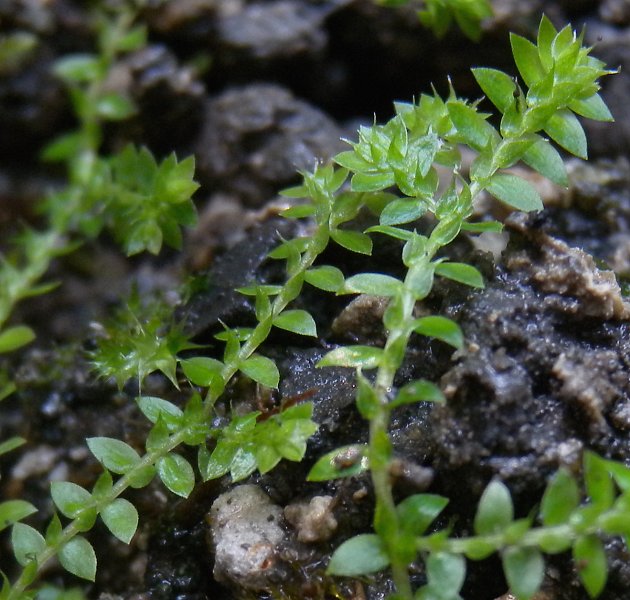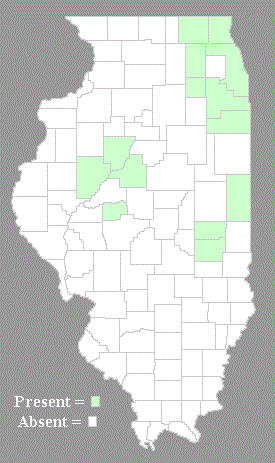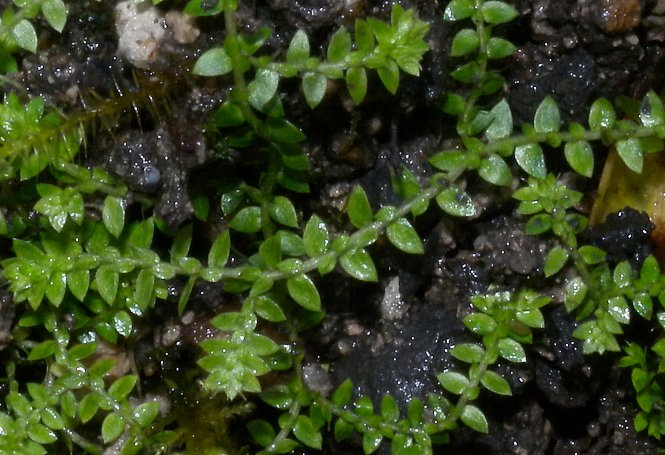
The bases of horizontal leaves are rounded or slightly cordate, while their tips are acute. The vertical leaves are about 1.0 mm. long and 0.5 mm. across; they are usually lanceolate in shape and finely serrated along their margins (requires at least 10x magnification to see). The bases of vertical leaves are rounded, while the tips of vertical leaves are elongated and very slender, curving toward one side. Both the upper and lower sides of these leaves are light to medium green and glabrous. The lower or inner sides of these leaves have minute air pores scattered throughout, while their upper or outer sides have minute air pores concentrated primarily along their margins. These leaves have central veins of varying visibility, where they are keeled along their lower or inner sides. Occasionally, infertile leafy stems also produce short lateral stems that terminate in strobili (leafy bracts with spores). This typically happens after 4-12 pairs of lateral (or vertical) leaves are produced. The lateral stems are typically ½–2" (12.5–50 mm.) long and ascending, rather than sprawling. At the base of some lateral stems, there maybe 4-ranks of leaves like the longer stems. However, these leaves are shortly replaced by terminal strobili (leafy bracts with spore-bearing structures). Each strobilus consists of 4-ranks of leafy bracts that are called sporophylls (2 ranks of large sporophylls and 2 ranks of small sporophylls). The large sporophylls are similar in shape, size, and appearance to the horizontal leaves, while the small sporophylls are similar in
 shape, size, and appearance to the vertical leaves. However,
the sporophylls are slightly larger in size overall, and they are more
crowded together and overlapping. The large
sporophylls produce both megaspores and microspores from their axils,
while the small sporophylls produce only microspores. The megaspores
have a diameter of about 330 micrometers, while the microspores have a
diameter of about 22 micrometers. The megaspores are spheroid in shape
overall with trilateral ridges along one hemisphere. The megaspore
surface is somewhat loosely reticulate and slightly warty in
appearance. The megaspores are
typically spread by water (and possibly animal carriers), while the
microspores are typically spread by wind or water. The root system of
this plant is white, fibrous, and poorly developed. Adventitious roots
often develop from the rhizophores along infertile stems, making this
evergreen plant a perennial in its growth habit.
shape, size, and appearance to the vertical leaves. However,
the sporophylls are slightly larger in size overall, and they are more
crowded together and overlapping. The large
sporophylls produce both megaspores and microspores from their axils,
while the small sporophylls produce only microspores. The megaspores
have a diameter of about 330 micrometers, while the microspores have a
diameter of about 22 micrometers. The megaspores are spheroid in shape
overall with trilateral ridges along one hemisphere. The megaspore
surface is somewhat loosely reticulate and slightly warty in
appearance. The megaspores are
typically spread by water (and possibly animal carriers), while the
microspores are typically spread by wind or water. The root system of
this plant is white, fibrous, and poorly developed. Adventitious roots
often develop from the rhizophores along infertile stems, making this
evergreen plant a perennial in its growth habit.Cultivation: The preference is dappled sunlight to medium shade, wet to consistently moist conditions, and calcareous soil containing gravel, rocky material, or sand. This plant tolerates competition from other plants to only a limited extent. However, it can develop quickly from a germinating megaspore to a mature spore-bearing plant in as little as 80-90 days (Schulz et al., 2010).
Range & Habitat: Hidden Spike-moss (Selaginella eclipes) is an uncommon plant that occurs in central and northern Illinois, where it is native. It has primarily a boreal distribution in North America; Illinois lies along its southern range-limit, although there are isolated populations in Arkansas and Oklahoma. Habitats include gravelly hillside seeps and low areas along springs in rocky areas. It may also occur in other wetland habitats that are calcareous, such as marly areas of fens and White Cedar swamps. Generally, Hidden Spike-moss occurs in high quality natural areas.
Faunal Associations: At the present time, information about floral-faunal relationships for Hidden Spikemoss (Selaginella eclipes) are unavailable. Because this plant species was described relatively recently, information is very limited.
Photographic Location: A gravelly hillside seep at Turkey Run State Park in west-central Indiana.
Comments: For a long time, Hidden Spikemoss (Selaginella eclipes) was regarded as the same species as Meadow Spikemoss (Selaginella apoda). Because of their appearance and diminutive size, both of these plant species are easily confused with mosses. However, spikemosses (Selaginella spp.) are primitive vascular plants, while true mosses are non-vascular plants. The closest relatives of spikemosses in Illinois are probably the quillworts (Isoetes spp.), even though the latter look superficially like tufted grasses or sedges. Like spikemosses, quillworts reproduce with microspores fertilizing the larger megaspores. This characteristic is considered, by some biologists, as an evolutionary precursor of more modern seed-bearing plants.

Hidden Spikemoss can be distinguished from moss species by its 4-ranked leaves, consisting of 2 ranks of larger horizontal leaves a 2 ranks of smaller vertical leaves along the same stem. Mosses usually produce leaves about the same size along their stems, although the size of their leaves can vary across primary and secondary stems. In addition, mosses produce spore-bearing capsules, often on long slender stalks, and their spores are uniform in size. Hidden Spikemoss can be distinguished from Meadow Spikemoss primarily by their vertical leaves: the vertical leaves of Hidden Spikemoss have long slender tips that curve to one side, while the vertical leaves of Meadow Spikemoss have shorter acute tips. The megaspores of these two spikemosses are also slightly different in appearance: the megaspores of Hidden Spikemoss are less strongly reticulated-warty than those of Meadow Spikemoss. Hidden Spikemoss also appears to be a more conservative species that occurs in high quality natural areas consisting primarily of hillside seeps, rocky springs, and fens (at least in Illinois & neighboring states). In contrast, it is not uncommon to find Meadow Spikemoss in pastures, lawns, and other disturbed habitats. In Illinois, these two spikemosses have non-overlapping distributions: Hidden Spikemoss occurs in the northern and central sections of the state, while Meadow Spikemoss occurs in southern Illinois.